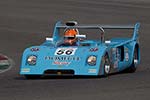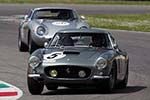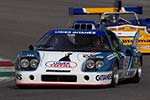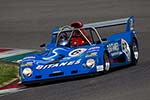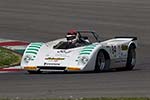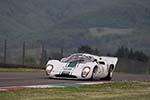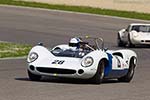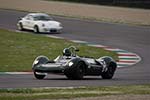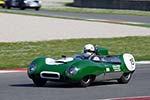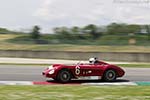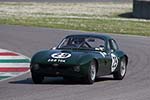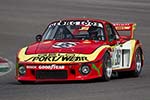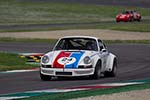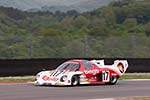Introduction

After two years at Imola, Peter Auto's Italian event moved to Mugello for 2014 for the inaugural Mugello Classic. Located in the Tuscan hills just north of Florence, Mugello hosted its first race 100 years ago using a 66 km long road course. Among the winners of Mugello Road Race were the likes of Giuseppe Campari and Antonio Ascari while also Enzo Ferrari drove an Alfa Romeo to class victory in 1921. After 1929, the race was abandoned only to be re-established during the 1960s. From 1973, a purpose built circuit was constructed making the most of the undulating area. Today, the circuit is owned by Ferrari and hosts a round of the Moto GP World Championship. During the 2012 season, it was also used for Formula 1 testing, prompting Mark Webber to remark: "Did 10 dry laps today around Mugello, which is the same as doing 1000 laps around Abu Dhabi track in terms of satisfaction."
The action-packed Mugello Classic featured most of Peter Autos familiar grids, including the headlining Classic Endurance Racing field, split over two separate races. Among the support events were three single seater races, ranging from late 1950s Formula Juniors all the way through to much more recent GP2 machinery.
We ventured to this particularly beautiful part of Italy for the first time and have come away with this spectacular
240-shot gallery of the first Mugello Classic.
Single seater support races

The earliest of the single seaters out on track in Mugello competed in the Challenge Formula Storiche, featuring two 25-minute races. This grid boasted a colourful mix of Formula Junior and the later Formula 3 cars. Among the cars out on track were a front-engined Taraschi, a rare Chevron B9, a pair of Tecnos and a choice of Brabhams and Lotuses. Race 1 was won by Francois de Rossi in a Chevron B17, while the second race fell to Christian Traber in a Brabham BT21. A slightly more modern breed of single seater also completed two 25-minute races, this time for the F3 Classic championship. Following close battles, both rounds were ultimately won by Jean-Pierre Eynard Machet, driving the Mk 31 Martini, which had originally been piloted by Philippe Alliot while he climbed the ranks to Formula 1. The most modern cars on track during the Mugello Classic were found the XL Formula & BOSS GP races, which included single seaters from feeder series like the World Series by Nissan and Renault, and also GP2. These were completed by a pair of Indy Cars from the 2000s. Gary Hauser ended both 25-minute races on top in his GP2 Dallara.
Trofeo Nastro Rosso

Competing on home turf were the cars of the Trofeo Nastro Rosso, dedicated two Italian sports and GT cars from the late 1950s through to the mid 1960s. Most cars on the grid in Mugello were regulars that had competed in the Trofeo Nastro Rosso. One of the exceptions was the Ferrari 250 GT SWB brought and raced by Lukas Hueni. This is one of the ultimate specification 'SEFAC Hot Rods' and was raced in period by the Rodriguez brothers for the North American Racing Team. In his tome on 250 GT competition cars, Jess G. Pourret simply describes this particular car as 'very fast'. Hueni proved this once more by placing sixth in the first 45-minute race but then elected to sit out the second race. Starting from pole both times was Carlos Monteverde in his ex-Ecurie Franchorchamps Ferrari 250 LM. He led race 1 from start to finish to take the victory. The second race was an altogether more difficult affair as he was beaten to the first corner by two Bizzarrinis. Within a few laps, he had regained the lead but then hit mechanical problems, first losing the right-hand side exhaust and then with two laps to go one of his rear wheels. The latter stopped him is track, promoting Michael Erlich in his Bizzarrini to first place.
Another all-Italian affair was the Alfa Revival Cup, which consisted mainly of Giulia derivatives. Run over one hour on Saturday afternoon, the race was won by Roberto Arnaldi in a GTAm.
Sixties' Endurance

True to its name, the Sixties' Endurance race was the longest of the weekend, lasting a full two hours. The 43-strong field featured a host of Cobras and E-Types at the sharp end but also rarer machinery like a Morgan +4 SLR and a genuine Porsche 904/6. Fastest of all in qualifying was Simon Hadfield, who shared a Cobra with owner Leo Voyazides. Starting fourth, it was Frenchman Yvan Mahe who grabbed the lead in his Cobra. Behind him an exciting battle between Voyazides and Jean-Marc Merlin in another Cobra lasted throughout the opening hour with the former valiantly holding on to second. After Hadfield had taken over from Voyazides, he gradually closed the gap to Mahe, who was driving solo, at one point lapping a full two seconds a lap faster than his time in qualifying. At the two hour mark, Hadfield crossed the line three seconds ahead of Mahe but was ultimately classified third after receiving a one-lap penalty. Jean-Marc Merlin was classified second, making it an all-Cobra podium. Best of the rest were Dominique Vananty and Olivier de Siebenthal in their Shelby Mustang GT350 and Carlo and Yves Vogele sharing the Porsche 904/6. Clinching victory in the Index of Performance were Vincent Tourneur and Duthie Glen with a Porsche 356 Speedster from 1954.
Classic Endurance Racing 1

Undoubtedly the most evocative line-up of cars was found in the Classic Endurance Racing 1 field for sports cars up to 1971 and GTs up to 1974. Among the stars were the five litre sports cars like several examples of the Lola 70 Mk3B and a single Ferrari 512 M. Our eye was particularly caught by Gianluca Rattazzis striking Alfa Romeo 33/3 Spider, which he shared with Nanni Galli. The former Grand Prix racer still holds the lap record on the original 66 km course of the Mugello road race. He has certainly not lost his edge as piloted the freshly restored three-litre Alfa with great verve. He was, however, unable to match the pace of the big Lolas and Martin O'Connell, who grabbed pole in a Chevron B19. Driving solo, O'Connell led the virtually from start to finish in the nimble Chevron, which proved quicker than the Lolas despite the 1.1 km start-finish straight. Hadfield and Voyazides finished second in the latter's T70, while Pierre-Alain France placed third in another Mk3B T70. Grabbing top honours in the GT class was Jean-Philippe Grand in his ex-Brumos Porsche 911 Carrera RSR 2.8.
Classic Endurance Racing 2

The most modern sports and GT cars were found in the second Classic Endurance Racing grid, which also featured a choice of Lolas and Chevrons. Among the more unusual cars was Marc Devis' Rondeau M378, which holds the distinction as the car with the single most Le Mans entries; 10. A local favourite, no doubt, was the Fabio and Antonio Valle piloted Lancia Beta Montecarlo. Certainly hard to miss were the BMW M1s, which, like many other cars, were fitted with new silencers. As a result, the M1s produced bigger flames than ever before. Hadfield and Voyazides again featured at the sharp end of the field with the latter's newly acquired Lola T282, which was placed on pole by Hadfield in the dying seconds of the second qualifying session. Martin O'Connell was hot on their heels in B36 Chevron and at the start jumped Voyazides to clinch the lead, which he would not give up. Philippe Scemama finished second in his DFV-engined Lola T290 just ahead of Paul Knapfield, who shared his similarly powered March 76S with seasoned GT-racer Jamie Campbell-Walter. Nicolas d'Ieteren finished seventh overall and first in the GT class with the final Porsche 935 K3 built.
Final thoughts
Who are we to disagree with Mark Webber and our first visit to Mugello gives us no reason to do so. The venue is perfectly suited to this type of racing and the races provided more than match for the spectacular backdrops. The drivers we talked to all agreed that undulating track with its fast corners was great to drive on as well. We have tried to capture the beauty of the Mugello track and the machinery that competed on it this weekend in this
240-shot gallery.

 After two years at Imola, Peter Auto's Italian event moved to Mugello for 2014 for the inaugural Mugello Classic. Located in the Tuscan hills just north of Florence, Mugello hosted its first race 100 years ago using a 66 km long road course. Among the winners of Mugello Road Race were the likes of Giuseppe Campari and Antonio Ascari while also Enzo Ferrari drove an Alfa Romeo to class victory in 1921. After 1929, the race was abandoned only to be re-established during the 1960s. From 1973, a purpose built circuit was constructed making the most of the undulating area. Today, the circuit is owned by Ferrari and hosts a round of the Moto GP World Championship. During the 2012 season, it was also used for Formula 1 testing, prompting Mark Webber to remark: "Did 10 dry laps today around Mugello, which is the same as doing 1000 laps around Abu Dhabi track in terms of satisfaction."
After two years at Imola, Peter Auto's Italian event moved to Mugello for 2014 for the inaugural Mugello Classic. Located in the Tuscan hills just north of Florence, Mugello hosted its first race 100 years ago using a 66 km long road course. Among the winners of Mugello Road Race were the likes of Giuseppe Campari and Antonio Ascari while also Enzo Ferrari drove an Alfa Romeo to class victory in 1921. After 1929, the race was abandoned only to be re-established during the 1960s. From 1973, a purpose built circuit was constructed making the most of the undulating area. Today, the circuit is owned by Ferrari and hosts a round of the Moto GP World Championship. During the 2012 season, it was also used for Formula 1 testing, prompting Mark Webber to remark: "Did 10 dry laps today around Mugello, which is the same as doing 1000 laps around Abu Dhabi track in terms of satisfaction." The earliest of the single seaters out on track in Mugello competed in the Challenge Formula Storiche, featuring two 25-minute races. This grid boasted a colourful mix of Formula Junior and the later Formula 3 cars. Among the cars out on track were a front-engined Taraschi, a rare Chevron B9, a pair of Tecnos and a choice of Brabhams and Lotuses. Race 1 was won by Francois de Rossi in a Chevron B17, while the second race fell to Christian Traber in a Brabham BT21. A slightly more modern breed of single seater also completed two 25-minute races, this time for the F3 Classic championship. Following close battles, both rounds were ultimately won by Jean-Pierre Eynard Machet, driving the Mk 31 Martini, which had originally been piloted by Philippe Alliot while he climbed the ranks to Formula 1. The most modern cars on track during the Mugello Classic were found the XL Formula & BOSS GP races, which included single seaters from feeder series like the World Series by Nissan and Renault, and also GP2. These were completed by a pair of Indy Cars from the 2000s. Gary Hauser ended both 25-minute races on top in his GP2 Dallara.
The earliest of the single seaters out on track in Mugello competed in the Challenge Formula Storiche, featuring two 25-minute races. This grid boasted a colourful mix of Formula Junior and the later Formula 3 cars. Among the cars out on track were a front-engined Taraschi, a rare Chevron B9, a pair of Tecnos and a choice of Brabhams and Lotuses. Race 1 was won by Francois de Rossi in a Chevron B17, while the second race fell to Christian Traber in a Brabham BT21. A slightly more modern breed of single seater also completed two 25-minute races, this time for the F3 Classic championship. Following close battles, both rounds were ultimately won by Jean-Pierre Eynard Machet, driving the Mk 31 Martini, which had originally been piloted by Philippe Alliot while he climbed the ranks to Formula 1. The most modern cars on track during the Mugello Classic were found the XL Formula & BOSS GP races, which included single seaters from feeder series like the World Series by Nissan and Renault, and also GP2. These were completed by a pair of Indy Cars from the 2000s. Gary Hauser ended both 25-minute races on top in his GP2 Dallara. Competing on home turf were the cars of the Trofeo Nastro Rosso, dedicated two Italian sports and GT cars from the late 1950s through to the mid 1960s. Most cars on the grid in Mugello were regulars that had competed in the Trofeo Nastro Rosso. One of the exceptions was the Ferrari 250 GT SWB brought and raced by Lukas Hueni. This is one of the ultimate specification 'SEFAC Hot Rods' and was raced in period by the Rodriguez brothers for the North American Racing Team. In his tome on 250 GT competition cars, Jess G. Pourret simply describes this particular car as 'very fast'. Hueni proved this once more by placing sixth in the first 45-minute race but then elected to sit out the second race. Starting from pole both times was Carlos Monteverde in his ex-Ecurie Franchorchamps Ferrari 250 LM. He led race 1 from start to finish to take the victory. The second race was an altogether more difficult affair as he was beaten to the first corner by two Bizzarrinis. Within a few laps, he had regained the lead but then hit mechanical problems, first losing the right-hand side exhaust and then with two laps to go one of his rear wheels. The latter stopped him is track, promoting Michael Erlich in his Bizzarrini to first place.
Competing on home turf were the cars of the Trofeo Nastro Rosso, dedicated two Italian sports and GT cars from the late 1950s through to the mid 1960s. Most cars on the grid in Mugello were regulars that had competed in the Trofeo Nastro Rosso. One of the exceptions was the Ferrari 250 GT SWB brought and raced by Lukas Hueni. This is one of the ultimate specification 'SEFAC Hot Rods' and was raced in period by the Rodriguez brothers for the North American Racing Team. In his tome on 250 GT competition cars, Jess G. Pourret simply describes this particular car as 'very fast'. Hueni proved this once more by placing sixth in the first 45-minute race but then elected to sit out the second race. Starting from pole both times was Carlos Monteverde in his ex-Ecurie Franchorchamps Ferrari 250 LM. He led race 1 from start to finish to take the victory. The second race was an altogether more difficult affair as he was beaten to the first corner by two Bizzarrinis. Within a few laps, he had regained the lead but then hit mechanical problems, first losing the right-hand side exhaust and then with two laps to go one of his rear wheels. The latter stopped him is track, promoting Michael Erlich in his Bizzarrini to first place. True to its name, the Sixties' Endurance race was the longest of the weekend, lasting a full two hours. The 43-strong field featured a host of Cobras and E-Types at the sharp end but also rarer machinery like a Morgan +4 SLR and a genuine Porsche 904/6. Fastest of all in qualifying was Simon Hadfield, who shared a Cobra with owner Leo Voyazides. Starting fourth, it was Frenchman Yvan Mahe who grabbed the lead in his Cobra. Behind him an exciting battle between Voyazides and Jean-Marc Merlin in another Cobra lasted throughout the opening hour with the former valiantly holding on to second. After Hadfield had taken over from Voyazides, he gradually closed the gap to Mahe, who was driving solo, at one point lapping a full two seconds a lap faster than his time in qualifying. At the two hour mark, Hadfield crossed the line three seconds ahead of Mahe but was ultimately classified third after receiving a one-lap penalty. Jean-Marc Merlin was classified second, making it an all-Cobra podium. Best of the rest were Dominique Vananty and Olivier de Siebenthal in their Shelby Mustang GT350 and Carlo and Yves Vogele sharing the Porsche 904/6. Clinching victory in the Index of Performance were Vincent Tourneur and Duthie Glen with a Porsche 356 Speedster from 1954.
True to its name, the Sixties' Endurance race was the longest of the weekend, lasting a full two hours. The 43-strong field featured a host of Cobras and E-Types at the sharp end but also rarer machinery like a Morgan +4 SLR and a genuine Porsche 904/6. Fastest of all in qualifying was Simon Hadfield, who shared a Cobra with owner Leo Voyazides. Starting fourth, it was Frenchman Yvan Mahe who grabbed the lead in his Cobra. Behind him an exciting battle between Voyazides and Jean-Marc Merlin in another Cobra lasted throughout the opening hour with the former valiantly holding on to second. After Hadfield had taken over from Voyazides, he gradually closed the gap to Mahe, who was driving solo, at one point lapping a full two seconds a lap faster than his time in qualifying. At the two hour mark, Hadfield crossed the line three seconds ahead of Mahe but was ultimately classified third after receiving a one-lap penalty. Jean-Marc Merlin was classified second, making it an all-Cobra podium. Best of the rest were Dominique Vananty and Olivier de Siebenthal in their Shelby Mustang GT350 and Carlo and Yves Vogele sharing the Porsche 904/6. Clinching victory in the Index of Performance were Vincent Tourneur and Duthie Glen with a Porsche 356 Speedster from 1954. Undoubtedly the most evocative line-up of cars was found in the Classic Endurance Racing 1 field for sports cars up to 1971 and GTs up to 1974. Among the stars were the five litre sports cars like several examples of the Lola 70 Mk3B and a single Ferrari 512 M. Our eye was particularly caught by Gianluca Rattazzis striking Alfa Romeo 33/3 Spider, which he shared with Nanni Galli. The former Grand Prix racer still holds the lap record on the original 66 km course of the Mugello road race. He has certainly not lost his edge as piloted the freshly restored three-litre Alfa with great verve. He was, however, unable to match the pace of the big Lolas and Martin O'Connell, who grabbed pole in a Chevron B19. Driving solo, O'Connell led the virtually from start to finish in the nimble Chevron, which proved quicker than the Lolas despite the 1.1 km start-finish straight. Hadfield and Voyazides finished second in the latter's T70, while Pierre-Alain France placed third in another Mk3B T70. Grabbing top honours in the GT class was Jean-Philippe Grand in his ex-Brumos Porsche 911 Carrera RSR 2.8.
Undoubtedly the most evocative line-up of cars was found in the Classic Endurance Racing 1 field for sports cars up to 1971 and GTs up to 1974. Among the stars were the five litre sports cars like several examples of the Lola 70 Mk3B and a single Ferrari 512 M. Our eye was particularly caught by Gianluca Rattazzis striking Alfa Romeo 33/3 Spider, which he shared with Nanni Galli. The former Grand Prix racer still holds the lap record on the original 66 km course of the Mugello road race. He has certainly not lost his edge as piloted the freshly restored three-litre Alfa with great verve. He was, however, unable to match the pace of the big Lolas and Martin O'Connell, who grabbed pole in a Chevron B19. Driving solo, O'Connell led the virtually from start to finish in the nimble Chevron, which proved quicker than the Lolas despite the 1.1 km start-finish straight. Hadfield and Voyazides finished second in the latter's T70, while Pierre-Alain France placed third in another Mk3B T70. Grabbing top honours in the GT class was Jean-Philippe Grand in his ex-Brumos Porsche 911 Carrera RSR 2.8. The most modern sports and GT cars were found in the second Classic Endurance Racing grid, which also featured a choice of Lolas and Chevrons. Among the more unusual cars was Marc Devis' Rondeau M378, which holds the distinction as the car with the single most Le Mans entries; 10. A local favourite, no doubt, was the Fabio and Antonio Valle piloted Lancia Beta Montecarlo. Certainly hard to miss were the BMW M1s, which, like many other cars, were fitted with new silencers. As a result, the M1s produced bigger flames than ever before. Hadfield and Voyazides again featured at the sharp end of the field with the latter's newly acquired Lola T282, which was placed on pole by Hadfield in the dying seconds of the second qualifying session. Martin O'Connell was hot on their heels in B36 Chevron and at the start jumped Voyazides to clinch the lead, which he would not give up. Philippe Scemama finished second in his DFV-engined Lola T290 just ahead of Paul Knapfield, who shared his similarly powered March 76S with seasoned GT-racer Jamie Campbell-Walter. Nicolas d'Ieteren finished seventh overall and first in the GT class with the final Porsche 935 K3 built.
The most modern sports and GT cars were found in the second Classic Endurance Racing grid, which also featured a choice of Lolas and Chevrons. Among the more unusual cars was Marc Devis' Rondeau M378, which holds the distinction as the car with the single most Le Mans entries; 10. A local favourite, no doubt, was the Fabio and Antonio Valle piloted Lancia Beta Montecarlo. Certainly hard to miss were the BMW M1s, which, like many other cars, were fitted with new silencers. As a result, the M1s produced bigger flames than ever before. Hadfield and Voyazides again featured at the sharp end of the field with the latter's newly acquired Lola T282, which was placed on pole by Hadfield in the dying seconds of the second qualifying session. Martin O'Connell was hot on their heels in B36 Chevron and at the start jumped Voyazides to clinch the lead, which he would not give up. Philippe Scemama finished second in his DFV-engined Lola T290 just ahead of Paul Knapfield, who shared his similarly powered March 76S with seasoned GT-racer Jamie Campbell-Walter. Nicolas d'Ieteren finished seventh overall and first in the GT class with the final Porsche 935 K3 built.



